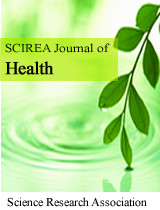Prevalence of anemia among reproductive age women at selected health centre, Alahsa
DOI: 376 Downloads 16670 Views
Author(s)
Abstract
Back Ground: People of all ages, races and ethnicity can develop anemia at some point in their lives. It can be treated successfully or prevented. Southeast Asia has more prevalence with nearly 800 million affected. World Health Organization estimated that 35% to 75% of pregnant women in developing countries and 18% of women from industrialized countries are anemic. Prevalence of anemia among women of reproductive age in Saudi was reported at 42.9% in 2016, by World Bank collection of development indicators. Objectives: The objectives are to assess the prevalence of anemia, and to associate with the selected demographic variables of women at their reproductive age.Methods: Descriptive research design was undertaken in this study to assess the prevalence of anemia among reproductive aged women in Alahsa. A sample of 200 women was selected randomly. The data was collected from women who met inclusion criteria to assess the prevalence of anemia. The data was analyzed by using descriptive and inferential statistics.Results: Among 200 women 22% were in the age group of <20 years and 45% were in 20-30 years. Regarding education none of them are non-literate and majority 59% were studied higher secondary schools and 79% of them were housewives. Totally 64% of them were married and 33 women were having more than 3 children, 69% were getting regular menstrual period and 31% were irregular, 80% women were having normal blood flow during their menstruation. Totally 17% women were having hemoglobin level >15gm/dl, 38% were having 12-15gm/dl, 41% were having 8-12gm/dl and 4% of them were having <8gm/dl. Hence, the overall prevalence of anemia was 45%.Conclusion: The study findings evidenced that majority of the women especially in reproductive age group were anemic. Hence, there should be necessary to create awareness among the women.
Keywords
Prevalence, reproductive age women, anemia
Cite this paper
Sahbanathul Missiriya, Tahani Alabdusalam, Ghofran Albaqal, Hawraa Alghadeer,
Prevalence of anemia among reproductive age women at selected health centre, Alahsa
, SCIREA Journal of Health.
Volume 3, Issue 1, February 2019 | PP. 13-23.
References
| [ 1 ] | Allen LH. Anemia and iron deficiency: effects on pregnancy outcome. American Journal of Clinical Nutrition. 2000; 71(5): 1280S–4S. [PubMed]. |
| [ 2 ] | World Health Organization. Global targets 2025. To improve maternal, infant and young child nutrition (www.who.int/nutrition/topics/nutrition_ globaltargets2025/en/, accessed 6 October 2014). |
| [ 3 ] | World Health Organization. WHO guidelines on nutrition (http://www.who. int/publications/guidelines/nutrition/en/, accessed 21 October 2014). |
| [ 4 ] | Geneva: Switzerland: World Health Organization; 2001. WHO/UNICEF/UNU. Iron Deficiency Anemia Assessment, Prevention, and Control; p.114. |
| [ 5 ] | Beard JL, Connor JR. Iron status and neural functioning. Annual Review of Nutrition. 2003; 23: 41–58. |
| [ 6 ] | Christopher VC, Alastair JSS, Cate ED. Anemia in Cambodia: prevalence, etiology and research needs. Asia Pacific Journal of Clinical Nutrition. 2012; 21(2): 171-81. |
| [ 7 ] | World Health Organization. Geneva, Switzerland: World Health Organization; 1992. The Prevalence of Anemia in Women: A Tabulation of Available Information, Tech. Rep. WHO/NUT/MCM/92.2. |
| [ 8 ] | Stevens GA, Finucane MM, De-Regil LM, Paciorek CJ, Flaxman SR, Branca F et al. Global, regional, and national trends in haemoglobin concentration and prevalence of total and severe anaemia in children and pregnant and non-pregnant women for 1995–2011: a systematic analysis of population-representative data. Lancet Global Health. 2013; 1: E16–E25. |
| [ 9 ] | https://data.worldbank.org/indicator/sh.prg.anem. |
| [ 10 ] | Jeffery LM, Iron Deficiency Anemia: A Common and Curable Disease. Cold Spring Harbor Perspectives in Medicine. 2013; 3(7): a011866. |
| [ 11 ] | Isah HS, Fleming AF, Ujah IAO, Ekwempu C.C. Anaemia and iron status of pregnant and non-pregnant women in the Guinea savanna of Nigeria. Annals of Tropical Medicine & Parasitology.1985; 79: 485-93. |
| [ 12 ] | Shali T, Singh C, Goindi G. Prevalence of anemia amongst pregnant mothers and children in Delhi. Indian Journal of Pediatrics. 2004; 71:946. |
| [ 13 ] | Mohammad ZS, Srinivas G, Tamal R, Riddhi D, Swastika C, Chhavi T, Nomita PK & Deepshikha S, Prevalence of Anemia and Its Determinants Among Pregnant, Lactating, and Nonpregnant Nonlactating Women in India. Sage Journals. 2017; 7(3): 1-10. |
| [ 14 ] | Chi Huu Hong Le, The Prevalence of Anemia and Moderate-Severe Anemia in the US Population (NHANES 2003-2012). PLoS One. 2016; 11(11): e0166635. |
| [ 15 ] | Panyang R, Teli AB, Saikia SP. Prevalence of anemia among the women of childbearing age belonging to the tea garden community of Assam, India: A community-based study. Journal of Family Medicine and Primary Care. 2018;7(4):734-8. |
| [ 16 ] | Fotedar A, Bhasin JS, Chakravarty A, Kulkarni A, Bhalla G, Anwar F, Rao S. Effectiveness of iron-fortified infant cereals on hemoglobin levels of children aged 12-24 months: A cross-sectional study from New Delhi, India. Journal of Family Medicine and Primary Care. 2018;7(1):77-80. |
| [ 17 ] | Camaschella C. Understanding iron homeostasis through genetic analysis of hemochromatosis and related disorders. Blood. 2005; 106: 3710–7. |
| [ 18 ] | Brissot P, Troadec MB, Bardou-Jacquet E, Le Lan C, Jouanolle AM, Deugnier Y, et al. Current approach to hemochromatosis. Blood Reviews. 2008; 22:195–210. |
| [ 19 ] | Camaschella C, Poggiali E. Towards explaining “unexplained hyper ferritinemia” Haematologica. 2009; 94: 307–9. |
| [ 20 ] | Melku M, Alene KA, Terefe B, Enawgaw B, Biadgo B, Abebe M, Muchie KF, Kebede A, Melak T, Melku T. Anemia severity among children aged 6-59 months in Gondar town, Ethiopia: a community-based cross-sectional study. Italian Journal of Pediatrics. 2018;44(1):107. |
| [ 21 ] | Wen Jiang, Xiao-Guo Hua, Cheng-Yang Hu, Feng-Li Li, Kai Huang. The prevalence and risk factors of menstrual pain of married women in Anhui Province, China. European Journal of Obstetrics and Gynaecology and Reproductive Biology. 2018; 229: 190-94. |

